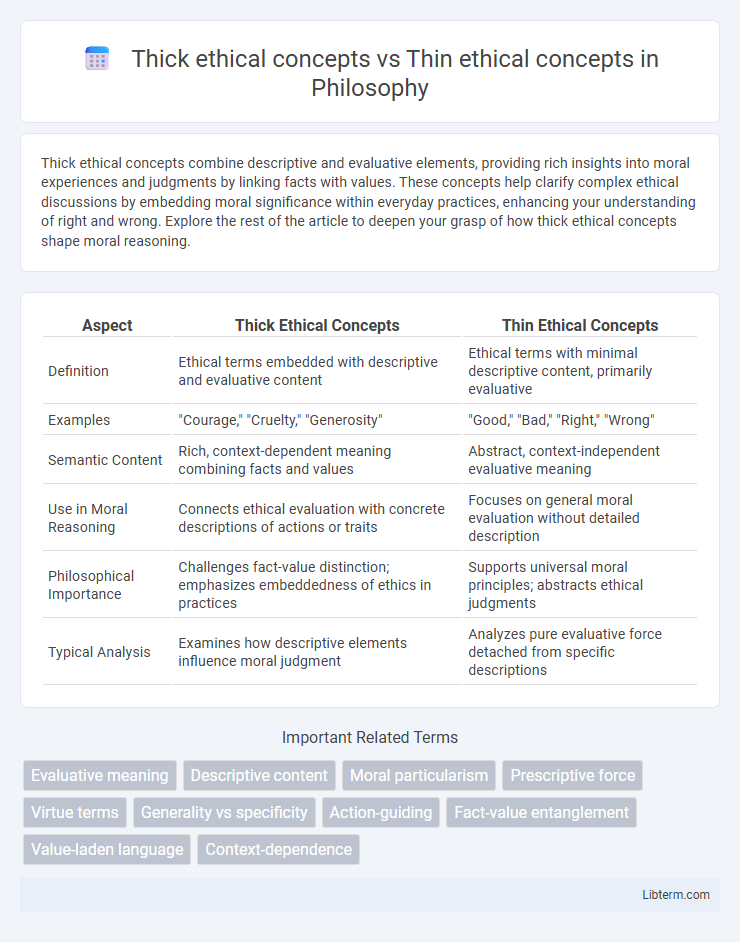Thick ethical concepts combine descriptive and evaluative elements, providing rich insights into moral experiences and judgments by linking facts with values. These concepts help clarify complex ethical discussions by embedding moral significance within everyday practices, enhancing your understanding of right and wrong. Explore the rest of the article to deepen your grasp of how thick ethical concepts shape moral reasoning.
Table of Comparison
| Aspect | Thick Ethical Concepts | Thin Ethical Concepts |
|---|---|---|
| Definition | Ethical terms embedded with descriptive and evaluative content | Ethical terms with minimal descriptive content, primarily evaluative |
| Examples | "Courage," "Cruelty," "Generosity" | "Good," "Bad," "Right," "Wrong" |
| Semantic Content | Rich, context-dependent meaning combining facts and values | Abstract, context-independent evaluative meaning |
| Use in Moral Reasoning | Connects ethical evaluation with concrete descriptions of actions or traits | Focuses on general moral evaluation without detailed description |
| Philosophical Importance | Challenges fact-value distinction; emphasizes embeddedness of ethics in practices | Supports universal moral principles; abstracts ethical judgments |
| Typical Analysis | Examines how descriptive elements influence moral judgment | Analyzes pure evaluative force detached from specific descriptions |
Introduction to Ethical Concepts
Thick ethical concepts, such as honesty and cruelty, integrate descriptive and evaluative meanings, providing a richer understanding of moral behavior within specific contexts. Thin ethical concepts like good and bad offer more general evaluative judgments without detailed contextual information. Understanding these concepts is essential for grasping how moral language conveys both factual and normative dimensions in ethical discussions.
Defining Thick Ethical Concepts
Thick ethical concepts combine descriptive and evaluative elements, capturing both factual characteristics and moral judgments, such as "cruel" or "brave." These concepts are context-dependent and provide rich, nuanced understanding by linking specific behaviors or traits to ethical evaluations. Defining thick ethical concepts involves recognizing their dual role in describing actions while simultaneously expressing approval or disapproval within social and cultural frameworks.
Defining Thin Ethical Concepts
Thin ethical concepts are abstract moral terms such as "good," "bad," "right," and "wrong" that provide minimal descriptive content and primarily serve to express approval or disapproval. These concepts lack detailed contextual information and do not convey specific qualities or character traits, distinguishing them from thick ethical concepts that combine descriptive and evaluative aspects. Thin ethical concepts function as general evaluative tools in moral reasoning and discourse without offering substantive guidance about particular situations.
Historical Background of Thick and Thin Concepts
Thick ethical concepts, rooted in complex cultural and historical contexts, emerged prominently in 20th-century moral philosophy, influenced by thinkers like Bernard Williams who emphasized the integration of descriptive and evaluative aspects in ethics. Thin ethical concepts, characterized by their generality and evaluative nature, trace back to classical philosophy with foundational ideas from Aristotle and Kant, focusing on universal moral principles stripped of rich contextual detail. The historical development of these concepts reflects a philosophical shift from broad, abstract moral reasoning toward acknowledging the nuanced interplay of cultural, social, and linguistic factors in ethical judgments.
Semantic Features of Thick Ethical Concepts
Thick ethical concepts combine descriptive and evaluative dimensions, embodying rich semantic content that conveys both factual information and moral assessment. These concepts, such as "courage" or "cruelty," possess complex semantic features including context sensitivity, normativity, and the capacity to guide action. Their dual nature differentiates them from thin ethical concepts, which primarily express simple evaluative judgments without substantial descriptive content.
Semantic Features of Thin Ethical Concepts
Thin ethical concepts possess a narrow semantic scope characterized by abstract, generalized meanings such as "good" or "bad," which lack specific descriptive content about actions or traits. These concepts serve primarily evaluative functions, enabling judgments without detailing the underlying reasons or context. Their semantic features include simplicity, universality, and flexibility, allowing wide applicability across various moral situations without conveying substantial informational content.
Examples of Thick and Thin Ethical Concepts
Thick ethical concepts combine descriptive and evaluative elements, such as "cruel," "courageous," and "generous," which convey both factual information and moral judgment. Thin ethical concepts are purely evaluative and abstract, including terms like "good," "bad," "right," and "wrong," providing minimal descriptive content. Examples of thick concepts are calling someone "dishonest," which implies both deceitful behavior and negative moral evaluation, while thin concepts like "right" denote ethical approval without specific behavioral details.
Moral Judgement and Meaning: Thick vs Thin
Thick ethical concepts combine descriptive content with moral judgment, providing a richer meaning that integrates facts and values, such as "cruel" or "brave." Thin ethical concepts, like "good" or "bad," offer minimal descriptive content and primarily convey a moral stance or approval without detailed context. The distinction influences moral judgment by shaping how evaluative language communicates both factual and ethical information simultaneously in thick concepts, whereas thin concepts function more as general expressions of ethical sentiment.
The Philosophical Debate on Ethical Concepts
Thick ethical concepts like "cruel" or "brave" integrate descriptive and evaluative elements, challenging the traditional separation between facts and values in moral philosophy. Thin ethical concepts such as "good" or "bad" are purely evaluative, prompting debates on whether moral language can convey substantive information beyond subjective attitudes. Philosophers like Bernard Williams and R.M. Hare have significantly contributed to the discourse, questioning how ethical concepts function in moral reasoning and influencing metaethical theories about the nature of moral language.
Implications for Moral Reasoning and Discourse
Thick ethical concepts, which combine descriptive and evaluative elements, enrich moral reasoning by providing nuanced understanding of actions within specific contexts, enabling more precise ethical judgments. Thin ethical concepts, being purely evaluative and abstract like "good" or "bad," facilitate broad moral discourse by allowing general comparisons without detailed contextual information. The interplay between thick and thin concepts shapes ethical discussions by balancing specificity and universality, affecting how moral agents interpret and communicate values across diverse situations.
Thick ethical concepts Infographic

 libterm.com
libterm.com